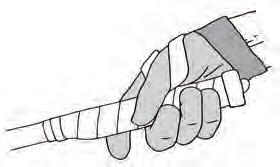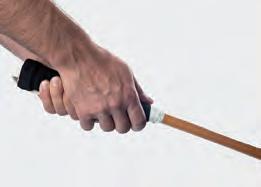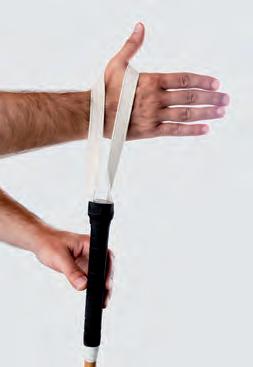
11 minute read
Mallet and Grip
Grip
Sling
Advertisement
the mallet
This chapter describes components and models as well as the selecting, maintenance and handling of a stick.
Traditionally, a polo mallet (also called stick or taco) consists of a willow or bamboo cane with a wooden head attached to it (stick head). Further models like sticks made of fiber, carbon or other composites are also available. The ball is struck with the longer sides of the mallet. Besides hitting a ball, the stick is also used for so-called sticking or hooking in defense. There is a sling at the grip which is supposed to prevent the player from losing the mallet during the game, for example while sticking another player.
There are various models of polo sticks. They vary in size of the grip, length, flexibility, material, material and shape of the stick head and weight. in the right hand only, even by Nearside hits, i.e. hits from the left-hand side of the pony, are hit
Cane
Mallet Head/ Hitting Surface/ Face Important: The stick must be held players who are left-handed.
Cigar by crossing the right arm over the mount’s neck!
Grip Size There are also different grip sizes available. The diameter of the grip range from grips for very small hands and children to mallets with big grips for strong players.
Length The length of the polo mallet depends on the height of the horse and on the player’s arms. The most popular mallet sizes are 51 to 53 inches. Professionals might also consider the length of the grass when selecting the stick.
Material As mentioned before, polo sticks are available in various materials. The typical stick with a bamboo cane is the most common. The flexibility of the stick is essentially influenced by the number of fiber bundles and therefore the number of nodes (knots or grains in the bamboo cane).
Mallet Head and Weight Mallet heads are available in different weights (between 160 and 250 grams) and in different shapes. Mostly, the stick head has the form of a cylinder, and for this reason it is called a “cigar”. This term will be used throughout the book, as 90% of the world’s players prefer this stick shape.
The toe of a cigar is often round while the heel is tapered. “Skene” and “R.N.P.A.” stick heads both can be distinguished by their tapered heel and toe. Argentine Tipa (Tipuana blanca) is undoubtedly the world’s most popular timber used for stick heads.
The weight of a mallet chiefly depends on the weight of its stick head.
Usually the length is printed on the stick head. To this, the customer’s initials are applied with a special dye. Often mallets are color-coded to help assign them to the players.
It is helpful to color-code sticks of different lengths because it simplifies seeing the different lengths from horseback (see picture on page 29).
Choosing the mallet
Selecting the right mallet should be assisted by a professional player. An experienced player is able to broadly estimate the physical qualities of a stick. For the average player a total weight of 520 grams (320 grams cane, 200 grams head) has been shown to be suitable. Sticks for women and children are lighter. The head should weigh at least 190 grams.
There are various theories and opinions on the selection of the suitable mallet length. Some players use the same stick length regardless of the horse or the conditions. Others recommend selecting a stick one inch shorter in the case of long grass or a soft playing surface (for example in an arena or on a beach), and one inch longer on hard surfaces (such as ice) and on highly wornout or very short grass.
Fundamentally, the mallet is the extension of the arm and should therefore be long enough that it brushes the grass when hitting.
Canes should be straightened after each use and mallets should be hung up by the cigar. Pay attention that your mallets are kept dry and out of the sun!
If you used your mallet on wet grass or if mallets became wet they should be dried afterwards. Wet conditions make the stick head spongy and fragile.
Many players protect the cigar against the soaking in of moisture with a strip of plastic tape. Before the game, do not forget to check if the head is still tightly attached to the cane without rotating.



Tips from the Pro
Broken mallets or stick heads can be repaired or be exchanged. Grip material can be either repaired or replaced by grip material from, for example, tennis. The best way to find the right mallet lengths is to do test swings on the horse in halt.

Pay attention that the mallet is long enough that you strike the grass of the field and suits you for hits on both sides of the horse – especially for nearside shots! For better differentiation, mark stick heads of different length with different colors.



Grip and sling
The term grip in polo can be used for both the grip of the stick and as a synonym for the correct way of holding your stick, i.e. the correct positioning of the hitting hand.
The latter shall be discussed first. Having learned how to hold your mallet correctly, you can check your suitable diameter and the effort needed for holding the mallet.
The Position of the Hitting Hand
It is most important to get used to the correct positioning of the hand at the grip. Here, there is only one correct technique. The grip always stays the same, whatever swing you perform – it never alters. The wrist movement has a very large influence on the swing technique, as along with the generation of a strong torque it also has the function of leading the mallet during the swing.
The mallet is to be held like a pistol, i.e. the index finger is in the trigger position. An illustration of the proper grip is shown on the left.
The “Pistol Grip”
Hold the grip in your palm and make sure the mallet is like an extension of your forearm. Close your hand and wrap your fingers from the middle to the little one around the grip. Your thumb must be placed on top. The index finger is positioned like holding a pistol. This position prevents you from holding the mallet like a hammer. The index finger stabilizes the grip and helps to control the mallet. If you look at the grip from above, index finger and thumb are supposed to form a “V”.
Please take care that you strictly avoid the grip shown on the left. It is called a “hammer grip”, because the fist is positioned as if holding a hammer.

1Grip the stick with the golf-club grip.

2Have your fi ngers slide to the upper end of your stick.

3Release your left hand.
A precise and correct grip,
enables you to make use of the mallet as an extension of your arm. enables you to control the mallet. makes sure there is optimal transmission of power between your body’s impulse and your mallet.
Tips from the Pro
Practice with a walking stick.


Find the correct position by putting the mallet head on the ground. Make sure you can see the writing on it. Then grab the stick to make it the ex tension of your stretched arm and do not forget to apply the pistol grip.
the sling – how to use it

1The sling is wrapped around the thumb and the back of the hand. The correct grabbing of sling and grip is described below.

2Adjust the sling, i.e. tighten it by twisting the thong.

3Grab the stick from above. Think about the pistol grip!

4Leave a free space of two fingers’ breadth between sling and back of the hand.
The sling has a slight supporting function and will help you to hold the mallet. Take care it is not adjusted too closely, otherwise you will not be able to release the mallet in precarious situations like serious sticking. Always try to consider this rule: You should be able to place two fingers between the sling and the back of your hand.
Grip Fitting
You will easily recognize a proper fitting – you should be able to comfortably fold the middle two fingers around the grip so their tips meet the flashy part of the palm, just beneath the thumb.

If the mallet grip is too big you will not be able to control your swing properly. Moreover, this tends to result in holding the mallet too firmly, which then leads to cramps in your wrist followed by rapid weariness and overstrain of your arm muscles.

If the mallet grip is too small the mallet head will start to lurch or rotate.

pressure on the Grip
Remember: Neither hold your grip too loosely nor too tightly. The ideal effort is diffi cult to explain in theory.

The perfect grip is comparable to the pressure you would apply to squeeze toothpaste out of its tube or like a solid confi dent handshake.
Holding the grip too loosely causes rotation of the mallet at the moment of impact. This affects the way the ball fl ies and the distance of the stroke.
On the other hand, holding the grip too strongly causes overstrain of the wrist and your lower arm muscles and you will not be able to perform a correct swing.

The pressure on the grip can be reduced by slightly relaxing the ring fi nger.
Tips from the Pro
Try to learn the correct hand position from the very beginning.
Develop a feeling for optimal grip pressure.
Use the sling correctly and practice the pistol grip.
Consider with every swing, no matter if offside or nearside: If you look at the stick head, you must be able to see the labels.


Remember, the grip always stays the same, no matter which swing you perform.
Once you determine which grip size suits you, be sure to have all your mallets made to that size by your manufacturer.
Grip material can be either repaired or replaced by grip material from other sports, like tennis for example.
Make sure the sling is not too tight to the back of your hand; there should be space for two fingers between sling and back of the hand.
Carrying the mallet

It is essential to carry the mallet ready for the next shot in order to perform a correct swing at any time. Head and cane face straight up in the air, i.e. the cigar is at the highest position, and the tapered end of the head is showing forward. With the elbow bent at your side the arm slightly touches the body. In this way, the mallet is in a very balanced position which requires little power and you are ready to strike the ball at any time. This position is often compared to holding a sword during ancient times.
During breaks in a chukka or a break between chukkas, or when you are riding to the fi eld or to the pony line, you just let the grip go and allow the mallet to lean against your shoulder. Ac- cording to experience, many polo players slip into an incorrect method of carrying the mallet.
These examples can often be seen on a fi eld:
Important

These positions might appear casual, but they are absolutely out of the question. They not only affect reaction time and energy but also put pressure on your wrist. Moreover, there is a danger of the mallet getting between the horses while you are riding off.
Tips from the Pro
Always start your swing from a correct position, holding the mallet balanced, because this is the most power-saving and a basic condition for a good swing technique.
The mallet must be held precisely to keep it in a balanced starting position. Make sure your hand position at the grip is correct. Professional players call it “Wrist Power Balance”.

If you carry the mallet correctly, it does not annoy the horse and there is no danger of the mallet getting between the horses when you are riding off.
Holding the mallet properly, you can easily and immediately perform nearside and offside swings.
Mane
Wither Hip
Point of Shoulder
Carpus
Fetlock Flank

Hock Joint Buttock
Tail
Canon










